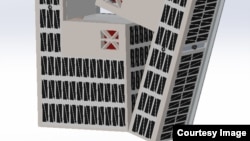A group of college students is hoping to place a satellite powered only by water into an orbit around the moon.
The students are from Cornell University in the state of New York. They are taking part in a competition called the Cube Quest Challenge. It is a program of NASA, the American space agency.
The Cornell team is called the CisLunar Explorers. The word cislunar means "between Earth and the moon.”
The challenge is simple: to design, build and deliver "flight-qualified, small satellites." NASA officials say the satellites must be able to perform "advanced operations near and beyond the moon."
Ten teams are taking part in the competition. But the CisLunar Explorer satellites are different. They are the only ones using water to power their spacecraft.
The idea for a water-powered vehicle came from Mason Peck, who works at Cornell University. He once worked as NASA's chief technologist. He has always wanted to use something other than rockets to push spacecraft beyond earth.
“A lot of the mass we send into orbit these days is in the form of rockets – the only way we get anything into space,” he said, in a Cornell press release.
“But what if we could use what’s already there? If we could do that, if we could refuel spacecraft while they’re already in space..."
The spacecraft is shaped like the English letter L. It measures about 30 centimeters in length, and the two pieces are connected.
Water is stored in the lower part of the satellite. The sun will separate the water into two elements: hydrogen and oxygen. When one combines hydrogen and oxygen with a spark, an explosion results. This provides a forward movement, known as thrust.
The CisLunar Explorer team has an unusual way to guide its spacecraft. The idea is to copy how old-time sailors used the moon, sun and stars to fix their position on the oceans. The satellite is equipped with cameras. The cameras will take pictures of the sun, Earth and the moon and compare their positions and their size.
Based on where the sun, moon and Earth are at any given time, the CisLunar Explorers will do the mathematics to find their position.
The competition is being held in four parts. The Cornell team has been among the top three competitors during parts one and two. The winners of the third stage will be announced in about a month.
The final three winners will be announced in early 2017. They will get to ride on NASA's space launch system in early 2018.
I’m Dorothy Gundy.
Kevin Enochs at VOA News wrote this story. Jim Dresbach adapted it for Learning English. George Grow was the editor.
We want to hear from you. Write to us in the Comments Section or visit our Facebook page.
________________________________________________________________
Words in This Story
quest – n. a long, difficult effort to find or do something
challenge - n. a difficult problem; something that is hard to do
deliver – v. to take something to a person or place
beyond – adj. on or to the farther side of something
spark - n. a small particle of a burning substance
stage – n. a piece or part of something







